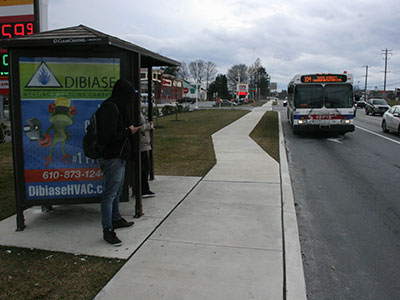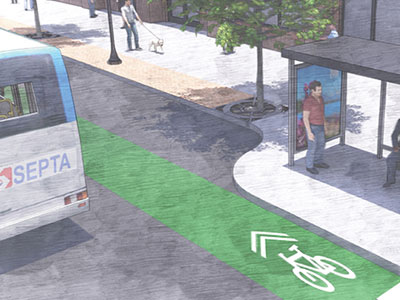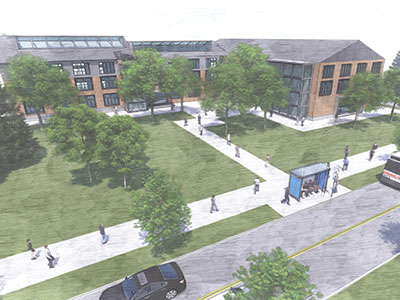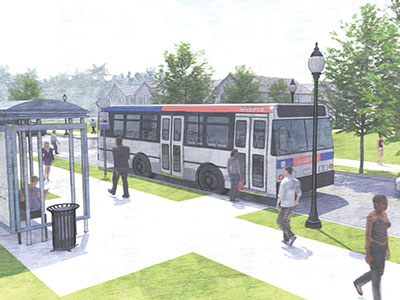The Exton Transportation Center provides appropriate waiting and loading facilities for bus passengers.
Some existing transit stops provide a shelter without providing the proper pedestrian access to the shelter.
This transit stop provides shelter and pedestrian access.
How it Works
Beyond a rider's experience in the transit vehicle, there are two additional significant components to a "full" transit ride: the connection between a transit stop and one's origin/destination; and the experience waiting for the arrival of the transit vehicle. In this context, the provision of amenities such as a bus shelter and sidewalk connections have influential roles regarding the quality of public transit in Chester County.
Chester County is served by many types of transit, and most municipalities that have nonresidential and denser residential development have places that are appropriate locations for transit stops and/or centers. Municipalities should make these transit locations as usable and comfortable as possible for transit users.
Transit stops are located along public bus routes in the urban and suburban municipalities served by public transit. The primary service provider in Chester County is SEPTA, although additional bus routes are provided by the Transportation Management Association of Chester County (TMACC) including the Coatesville Link and SCCOOT (a partnership with the Southern Chester County Organization on Transportation); and the Pottstown Area Rapid Transit (PART) which provides bus service to the Coventry Mall and North Coventry Township. In addition, many private shuttle services exist that use transit stops and centers to pick up and drop off passengers, including stops in shopping centers, office parks, industrial sites, and institutions.
Transit centers are hubs served by multiple transit routes and provide multimodal options and transfer opportunities for transit users. Transit centers within Chester County include the West Chester and Exton Transportation Centers. The Paoli Intermodal Transportation Center has recently been redesigned to provide multi-modal options for transit users, including maintaining existing coordinated bus route connections and providing for new coordinated shuttle service opportunities.
Transit agencies are not responsible for the design or maintenance of transit stops in Chester County. Therefore, the provision of high-quality transit stops requires a partnership between transit agencies, Transportation Management Associations, municipalities, PennDOT, and property owners.
Benefits
Increased Use of Public Transit
Transit stops and centers can provide safe, ADA-accessible, comfortable, and respectful opportunities for the utilization of transit services, which encourages greater public transit use and improves the commute of all transit users.
Improved Road Conditions
Properly-designed transit stops and centers provide room for passengers to board buses outside of through-lanes on local roads, improving traffic flow and road conditions. In addition, increased transit use can reduce traffic congestion.
Energy Conservation
With more public transit use, there is a reduced need for individual automobile trips, which can reduce gasoline use and energy consumption.
Urban centers are very appropriate locations for transit facilities and bus shelters.
Urban Center Landscapes Design Guide
Suburban center developments should be designed to accommodate bus riders, making it easy for them to walk from bus stops to destinations.
Suburban Center Landscapes Design Guide
Sidewalk connections are critical for bus shelters in suburban locations.
Suburban Landscapes Design Guide
Get Started
Municipalities usually plan for transit facilities in their comprehensive plan, provide design standards for these facilities in their subdivision and land development or zoning ordinances, require them during the land development process, and consider installing bus shelters and other facilities in high-use locations.
Municipal comprehensive plans should include general guidance on the potential location and design of transit stops, bus shelters, and transit centers. Any roads that have SEPTA, Chescobus, or PART fixed bus routes on them should have appropriate transit stops and shelters along them, including sidewalks to nearby destinations. These should be shown in the comprehensive plan. In addition, the plan should identify if commercial, higher-density residential, senior living, and institutional land use areas are intended for service by buses and private shuttles.
Subdivision and land development ordinances should have specific standards in them for bus stops and shelters, including a requirement that sidewalks be built to these locations. These standards can also be placed in the general standards or design standards of the zoning ordinance. In some cases, municipalities may want to require bus stops and shelters within specific zoning districts in the zoning ordinance, particularly if transit-access is integral to the intent and purpose of the zoning ordinance.
Considerations
Ownership and Maintenance of Bus Shelters
Since SEPTA will not own bus shelters, the ownership and ensuing maintenance of bus shelters is often a critical issue to resolve up front.
Type of Community
Design standards will vary by character of the area where the transit facilities are located. Dense urban downtowns will have limited land availability and more pedestrians, while suburban locations may have higher speed traffic on adjoining roads. The planning commission’s design guides for urban centers, suburban centers, and suburban landscapes provide guidance for different types of communities.
Design Limitations
Specific site factors may complicate the provision of transit stops and centers, such as topography; climate; sight distance; heavy and/or fast-moving vehicular traffic; narrow, limited, and varying rights of way; ADA-accessibility; subsurface utilities and above-grade obstructions; lighting; lack of public sidewalks and crossing protections, usage volume.
Multiple Party Cooperation
Cooperation and agreement between multiple parties is necessary before action can be taken, including but not limited to private property, local municipal ownership, state department of transportation jurisdiction and transit company oversight.

East Bradford Township
The zoning ordinance provides standards for bus stops/shelters in Section 115-54.
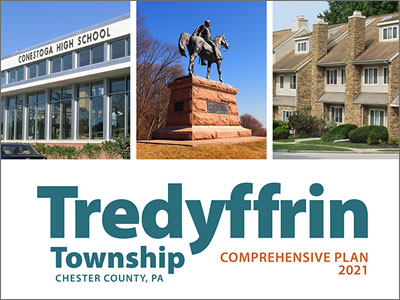
Tredyffrin Township
The comprehensive plan (2021) has good recommendations on improving transit connections and facilities.
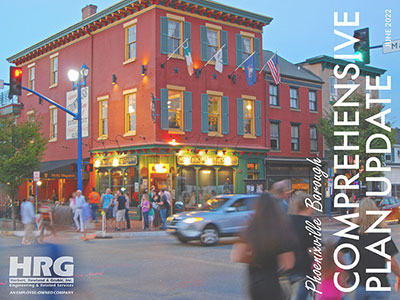
Phoenixville Borough
The "connected" chapter of the comprehensive plan update (2022) identifies the need for improved transit facilities
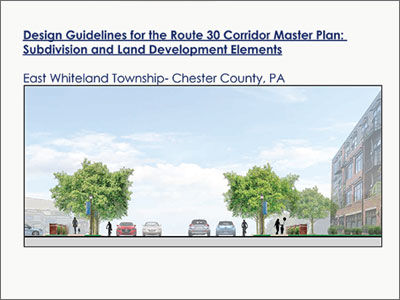
East Whiteland Township
Appendix F of Design Guidelines for the Route 30 Corridor Master Plan provides standards for bus stops and shelters.





